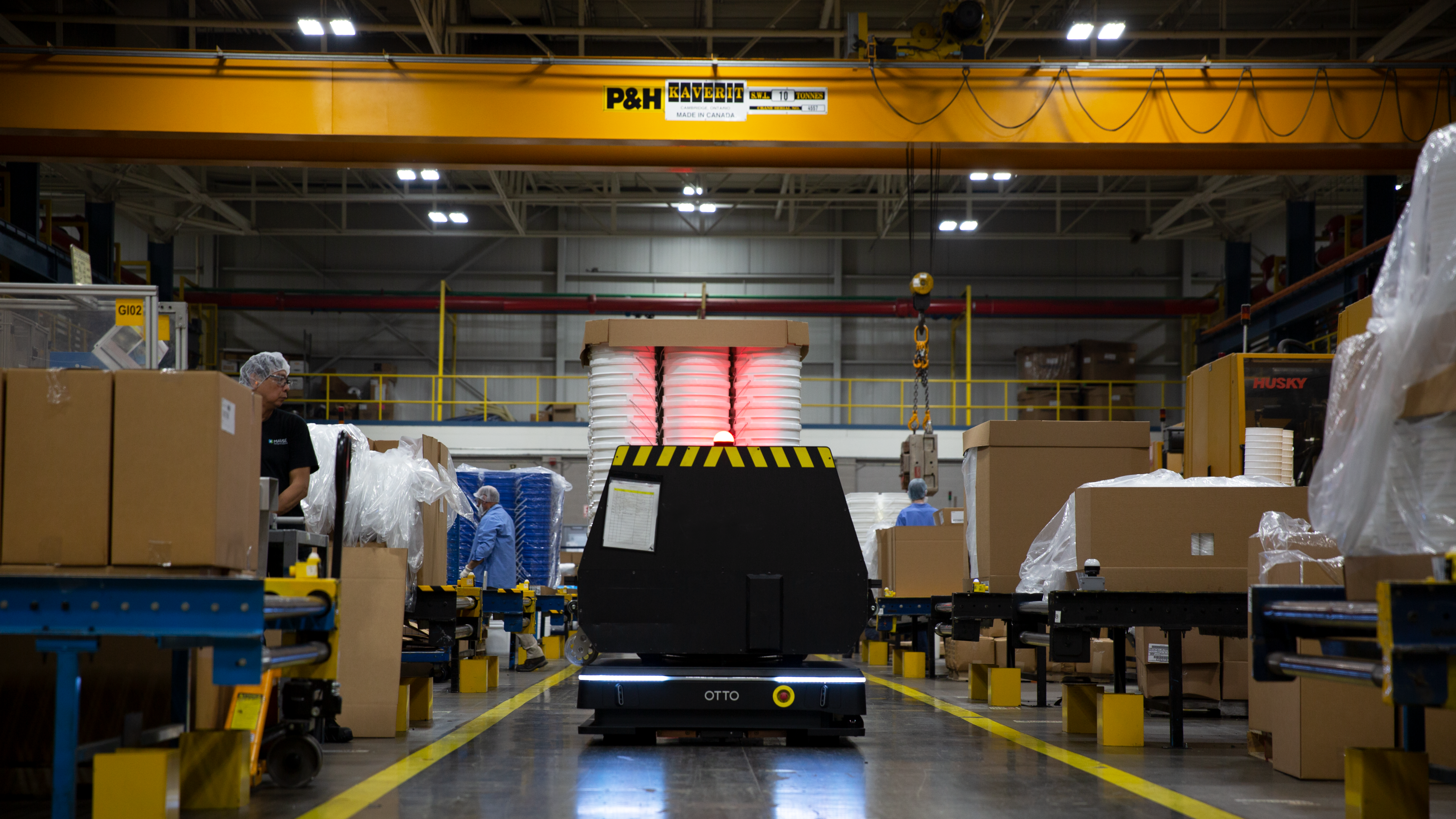A clear trend is flexible AI-driven material handling. Facilities are shifting from fixed material handling approaches. They’re investing in systems and equipment that adapt to the unpredictable demand and shifting just-in-time manufacturing and fulfillment needs. While several technologies provide flexibility, including independent cart conveyance technology, autonomous mobile robots (AMR robots) offer many exciting advantages.
AMR robots could provide the flexible material handling solution in your warehouse or on your factory floor.
1. What are autonomous mobile robots (AMRs)?
Autonomous mobile robots (AMRs) are intelligent, self-driving material handling vehicles capable of making real-time decisions in complex and dynamic environments. Unlike automated guided vehicles (AGVs) that follow a fixed path guided by QR Codes or magnetic tape, AMR robots move independently. Using AI sensors, cameras and advanced algorithms to make sense of their environment, AMR robots generate their own path and independently detect and avoid obstacles. This self-navigation capability lets AMR robots be more flexibly deployed in manufacturing or warehousing than AGVs or fixed conveyors – making them ideal for dynamic material handling environments.
2. How can AMR robots improve material handling productivity?
Since AMR robots aren’t on a fixed navigation path, operators can easily adjust AMR material handling workflows as operational needs change. Plus, using AMR robots in multiple applications unlocks new workflows for material handling automation.
For example, an autonomous forklift can be used for lane clearing and dock-to-dock transport, while flatbed AMR robots are ideal for lineside delivery and finished goods takeaway. This flexibility extends by sharing AMR robots across different facilities and redeploying them on demand.
Autonomous mobile robots can improve a facility’s overall productivity by operating continuously for six or more hours without recharging, resulting in steady material flow.
Manufacturers can start their material handling journey by piloting one or two AMR robots to confirm their value in action and generate excitement for the automation.
If manufacturers scale and deploy AMR robots as a fleet, the benefits increase exponentially. AMR robots help improve workplace safety, optimize material flow and fill labor gaps. Assigning AMR robots to repetitive tasks lets warehouses shift employees to more valuable decision-making roles. This improves operational efficiency and employee morale. Plus, AMRs help improve safety by reducing manual touchpoints and the risk of employee injury.
In tough hiring markets, AMR robots help facilities remain operational while simultaneously driving efficiency.
3. How intuitive is AMR robot fleet management software?
Fleet management software is key to managing AMR robot-driven material handling. This software coordinates the right AMR robot for the right task at the right time. It configures traffic rules on a centrally managed map that is distributed to all autonomous mobile robots in the manufacturing or warehouse facility.
Fleet management software is the connection point for facility integration, too. Instructions from ERP, WMS or MES systems are transferred to the fleet via software, enabling AMR robots to perform material transfers with facility equipment.
Robust fleet management software has a strong data and analytics tool to help analyze the system, proactively identify risks and improve your material flow. The solution dashboard helps communicate the health of your system in real-time – from visualizing KPIs to spotting bottlenecks to drilling down into specific AMR robots or actionable tasks.
4. How do AMR robots fit into your digital strategy?
Autonomous mobile robots are powerful sources of data within your digital operation. Real-time AMR robot performance data lets operators quickly visualize material flow efficiency. This data can be analyzed to drive facility-wide improvements, and by integrating data with your enterprise systems, you can optimize end-to-end performance.
For example, you may discover that urgent tasks aren’t getting completed on time and use telemetry data to improve order prioritization. Or you may notice that robot bottlenecks happen frequently in certain places. In that scenario, advanced analytics could indicate ways to reduce congestion and return to planned throughput.
Combining data from AMR robots and the rest of your facility can also inform end-to-end performance optimization across your broader operations. For example, you could construct a digital twin of your facility and try different approaches with zero risk and find small changes with a large impact. No matter what your goal, adding AMR data in your digital strategy offers opportunity to improve productivity.
AMR robots help improve warehouse logistics.
Flexible material handling is a necessity. The question is how to get there. AMR robots could be the answer. While autonomous mobile robots were considered cutting-edge technology a few years ago, their growth has increased exponentially over the past 10 years.
AMR robots allowed Mauser Packaging Solutions to increase throughput sixfold (6x) compared to their legacy AGV system. Faurecia Interior Systems improved safety and achieved an 11-month ROI. To learn more about the safety and productivity benefits of AMR robots for global manufacturers, find additional case studies here.
With a comprehensive AMR robot fleet, OTTO Motors by Rockwell Automation helps manufacturing and warehousing leaders implement the right AMR solution for their material handling needs. OTTO Motors was named one of the top autonomous mobile robot companies.
For companies seeking broader digital solutions support, experts from Kalypso, a Rockwell Automation business, helps develop end-to-end solutions to meet connected production goals.




